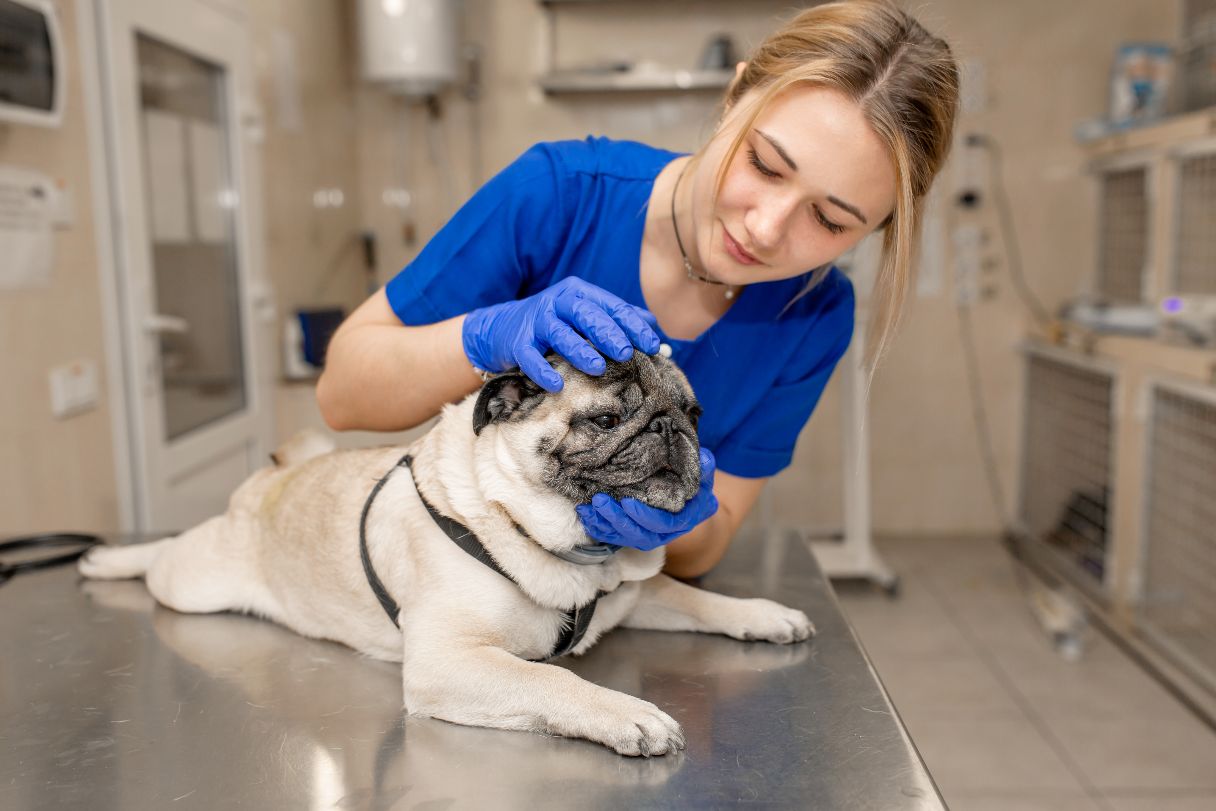Could your dog be deaf? An estimated 5% to 10% of dogs in the United States are affected by deafness or hearing loss.1 Just as with humans, many dogs lose their hearing as they age, while some are deaf from birth. Learn what else could cause dogs to lose their hearing, as well as how to tell if your dog is struggling with hearing loss and tips for how to help them.
Types of Deafness in Dogs
Deafness refers to total or near-total hearing loss in either one or both ears. Vets distinguish this from hearing impairment, which is when dogs can still hear, but not as well as they used to. Deafness may be unilateral, meaning deafness or hearing loss in only one ear, or bilateral, which means both ears are affected.1
Dog deafness has two types:
Acquired deafness
This is deafness that occurs later in a dog’s life due to something other than a heritable condition — anything from a severe ear infection or injury to systemic illness to old age.1
Common causes of acquired deafness in dogs include:
- Aging. It’s fairly common for a dog’s hearing to decline as they age, just as it is with people. This is most likely due to the eardrum becoming less flexible and therefore less able to transmit sounds to the brain.2
- Ear infections. Both ear infections and the buildup of ear wax can cause temporary deafness in dogs, which usually improves once the ears are properly cleaned or the infection clears up.3 However, dogs with chronic ear infections can develop ear damage that results in permanent deafness.2
- Endocrine disorders. Endocrine disorders can cause dogs to lose their hearing.1
- Injury. Traumatic injuries to either the head or the ear can damage a dog’s hearing and result in deafness.2 Loud noises can also cause injury to the eardrum, resulting in hearing loss.1
- Medications. Some medications are classified as ototoxic, which means they can damage the inner ear. These include certain antibiotics as well as antimalarial and chemotherapy drugs.1
Hereditary deafness
Hereditary deafness is caused by a genetic mutation that is passed from parents to puppies. It’s the most common reason for deafness in dogs. Often, this condition is also congenital, meaning it’s present at birth.1
Dogs born with a condition that makes them deaf usually have one of the following types of deafness:1
- Cochleosaccular deafness. This is deafness associated with the gene mutation that causes merle or piebald coat patterns in certain dog breeds. This gene also causes some dogs to have blue eyes. This type of deafness usually becomes apparent between 1 and 3 weeks of age.
- Neuroepithelial deafness. This deafness is caused by the loss of cochlear hair cells within the ear. Typically, both ears are affected. This type of deafness can also be detected by 3 weeks of age.
It should be noted that all puppies are technically born without hearing. Their ears are closed at birth but usually fully open by 3 weeks of age, which is when hearing should normally begin.4
How to Know if Your Dog Is Deaf
Here are a few ways you can tell if a puppy may have congenital deafness:2
- They seem slow to learn.
- They don’t learn verbal commands.
- They don’t respond to sounds like their hearing siblings do.1
It might be a bit more difficult to recognize when dogs have acquired hearing loss, especially if the hearing loss is gradual or it only affects one ear. Here are some telltale signs:1
- It’s hard to wake them when they’re sleeping.
- They bark loudly for no apparent reason.
- They don’t come when you call them.
- They don’t react to other dogs barking or to sounds that normally excite them.
- They don’t respond to verbal commands.
- They don’t wake up or react when you come home.
- They have trouble telling where a sound is coming from.
Dog Breeds Prone to Hereditary Deafness
Around 80 dog breeds have reported incidences of hereditary deafness, although it can occur in any breed. Dogs that carry the gene for merle or piebald coats and blue eyes tend to have the highest propensities.5
Here are some of the most common breeds that are prone to deafness:6
- Australian shepherd
- Beagle5
- Bulldog5
- Cardigan Welsh corgi2
- Dalmatian
- English setter
- Great Dane2
- Russell terrier
Hearing Loss in Senior Dogs
Age-related hearing loss in senior dogs typically occurs around 13 years of age.6 They usually start out no longer being able to hear higher frequency sounds, which means they may still seem to hear or react to sounds with a lower pitch.1 As their hearing goes, they may seem to ignore you when you speak to them or call them to you, and they may sleep more deeply and not wake up as easily.7 They may also appear to be confused by their surroundings.7
A correlation exists in senior dogs between deafness and canine dementia.8 Because of this — and also the fact that some signs of deafness, such as confusion or seeming to forget their name, could also be signs of dementia — it’s important to have a vet check your dog if you notice these signs.
Diagnosing Deafness in Dogs
If you suspect your dog might be deaf, there is a simple test you can do at home to be sure. Standing where your dog can’t see you or the source of the noise, perform the following to see how they react:2
- Jingle your keys
- Squeak their favorite toy
- Shake their treat bag
- Make additional noises, like whistling or clapping your hands
If your dog doesn't look around, perk up their ears or otherwise react to any of these noises, chances are they’ve lost their hearing.2
Even so, it’s best to have them examined by a vet to be sure. A vet will do a hearing assessment similar to what you performed at home, in addition to a physical examination to rule out underlying health conditions and determine whether the deafness is permanent or temporary due to an infection or excess ear wax.1
A more reliable test is the BAER test, which stands for brain stem auditory evoked response. This test is typically used by dog breeders to screen for hereditary deafness in dogs and puppies. It’s performed by a specialist and can give accurate results if that’s what you need. But it’s not actually required to diagnose deafness in your dog.1
Treating Dog Deafness
If your dog’s deafness is caused by an underlying health condition, treatment will focus on treating the condition. If deafness is temporary due to wax buildup or an ear infection, then treating the issue should restore the dog’s hearing.1
But often, the hearing loss is permanent. In such cases, as well as in cases of congenital deafness, there currently are no effective treatments to restore or improve hearing. Devices like hearing aids and cochlear implants for dogs are still in the experimental stage and are not yet widely available as treatment options. In most cases, treating a deaf dog focuses on training and accommodation.1
Tips for Living With a Deaf Dog
Here are some tips to help both you and your dog adapt to their deafness and to help keep them safe:1
- Consider microchipping your dog and registering them with a database.
- Have them wear a name tag with your contact information in case they get lost.
- Keep them on a leash or in a confined area when outdoors.
- Teach them hand signals in place of verbal commands.
Preventing Dog Hearing Loss
While you can’t always prevent hearing loss in your dog, you can lessen their chances by cleaning their ears regularly, treating infections promptly and protecting their ears from loud noises. You should also ask your vet about any medications they want to prescribe to be sure hearing loss isn’t a potential side effect.1
Dog breeders can help prevent hereditary deafness by not breeding dogs who are deaf, as well as not breeding together two dogs who both have the merle gene, which increases the likelihood of deafness.1
It can be heartbreaking to think that your dog will no longer hear or respond to the sound of your voice — or that they’ll never even know your voice. But with a few adjustments and accommodations, deafness in dogs doesn’t have to diminish their quality of life.
Frequently Asked Questions About Deafness in Dogs
Still have questions about deafness in dogs? Here are answers to some commonly asked questions on this topic.
CareCredit Credit Card Financing for Dogs
Taking good care of your pet's well-being from nose to tail is essential. Make sure to stay up to date on their regular checkups at the vet to help keep your pet happy and healthy for a lifetime of love. You can use your CareCredit credit card for pet care throughout the year for routine veterinary services as well as emergencies and surgeries.* Use our Acceptance Locator to find a veterinarian near you that accepts CareCredit.
CareCredit is there for you and your pet every step of the way; continue your wellness journey by downloading the CareCredit Mobile App to manage your account, find a provider on the go and easily access the Well U blog for more great articles, podcasts and videos.
In addition to pet care, you can also use your CareCredit credit card for dentistry, cosmetic, vision, hearing, health systems, dermatology, pharmacy purchases, spa treatments and so much more within the CareCredit network. How will you invest in your health and wellness next?
Author Bio
Jean Marie Bauhaus is a freelance writer and novelist who has been writing pet content since 2013. Her work has appeared on Forbes.com, Hill's Pet, Chewy, AKC.org and more.







